© 2012, Christian Cassidy
Today, 776 Main Street is a garden space adjoining the International Harvester / Vineyard Church building. back on Saturday, March 9, 1912, it was the scene of the fifth deadliest fire in Winnipeg's history that killed seven people, including two firemen, and injuring dozens more.The Radford-Wright Company was a door, sash, and millwright company based in Oshkosh, Wisconsin. In 1910, it dispatched E. M. Simonson to Winnipeg to establish a Canadian branch.
The company purchased 776 Main Street, the former Parlin and Orendoff Canadian Plow Co. building, located just north of the Higgins Avenue subway.
On the night of Saturday, March 9, 1912, a fire started in the lean-to annex at the rear of the building. An employee working late at the neighbouring Stuart Machinery building noticed the smoke and ran to a nearby fire call box. He also notified a policeman on the street.
Firefighters from nearby Fire Hall No. 3 on Maple Street, (now the Winnipeg Fire Fighters Museum), arrived on the scene in just a couple of minutes. They had just started to spray the annex when an "explosion that shook the earth for blocks around”.
It blew open the massive cargo doors at the rear of the building which sent flames and shrapnel into the faces of the firefighters. Then, the top portion of the rear wall collapsed to the ground and pinned five of them under two metres of rubble.
At the front of the building, the explosion sent sent debris, live power lines, and streetcar lines crashing down onto bystanders. The neighbourhood was plunged into darkness.
A general alarm was immediately called in and crews from most of the city's fire halls and every on-duty ambulance was summoned to the scene.
Source: Winnipeg Police Museum
Rescuers dug through the rubble at the rear of the building to get at the trapped firemen.
Charles McPherson and Edmond Molyneux were barely alive. They were rushed to St. Boniface hospital where Molyneux regained consciousness just long enough to witness last rites being given to his colleague. Both men died.
Earlier that day, the same firefighters responded to a hay barn fire and both had to be pulled unconscious from the structure due to smoke inhalation.
Source: Peel's
The main floor of the Sutherland Hotel across the street became a makeshift field hospital and morgue. Ambulances were routed there and a doctor was dispatched.
Police Sergeant Patrick, who was teaching a first aid class nearby when heard the explosion, brought his entire class with him to investigate the commotion and they went to work treating the wounded.
Newspaper accounts from the Sutherland describe a terrible scene of crushed bodies with missing limbs and the bloodied, bandaged wounded, lying on the floor or shuffling around the lobby in a daze. The din was interrupted by the odd cry when someone discovered the body of a loved one.
Adding to the chaos outside was the lack of streetcar service. The only access to and from the North End at the time was the Main Street subway. Late movies and a big hockey game had let out in the downtown and thousands of people had to squeeze through the disaster scene to get home.
The building continued to burn and disintegrate into the next afternoon. It was then that the rubble along Main Street was searched completely and final body pulled out. It was that of 12-year-old Charles Chapman of Patrick Street who was attracted to the scene by the sound of the fire engine gongs.
The dead:
Fireman Charles McPherson (29) - Fire Hall No. 3
Fireman Edmond Molyneux (24) - Fire Hall No. 3
Clarence Wiker (21) - CPR Employee
Leo Blute (24) – Bartender, Manor Hotel
Charles Chapman (12) - From Patrick Street
Walter Rowley (30) – Night watchman, Vulcan Iron Works
Antonio Nuranno - Died later in hospital
The injured firemen:
Fireman Robert McDonald - Fire Hall No. 3
Two broken legs, internal injuries, critically injured
Fireman Charles Schram - Fire Hall No. 3
Leg injuries, serious burns
Fireman Jack McKinnon - Fire Hall No. 3
Leg injuries, serious burns
Fireman Robert McDonald - Fire Hall No. 3
Two broken legs, internal injuries, critically injured
Fireman Charles Schram - Fire Hall No. 3
Leg injuries, serious burns
Fireman Jack McKinnon - Fire Hall No. 3
Leg injuries, serious burns
Funerals for most of the dead were held on March 12th. They were spaced throughout the day to make it easier for those who had to attend multiple funerals.
Newspapers from around North America reported on the tragedy and there was a great deal of pressure on fire officials to discover what caused the blaze.
They eventually determined that the cause of the fire was arson and the resulting explosion was due to naptha, a chemical stored in large quantities at the site.
They eventually determined that the cause of the fire was arson and the resulting explosion was due to naptha, a chemical stored in large quantities at the site.
It would take over a year before police got a lead in the case.
Patrick Dodds, a 23-year-old Scottish immigrant, was arrested on the evening of March 26, 1913 after being caught setting a fire on Smith Street. He confessed to setting around 200 fires since September 1911, claiming that the night of the federal reciprocity election was when his spree began.
When asked to provide details of the fires, he could only come up with 92 and included the Radford Wright fire. He told police that he set the deadly blaze, retreated a couple of blocks away, and then returned to the scene once firemen arrived. During the commotion he even spoke to first responders about the fire and manged to view the bodies of the two firefighters taken form the rubble.
One of the owners of the sign painting company that Dodds worked for at the time said that Dobbs was a good worker but had an eerie fascination with building fires and would recount to co-workers his stories of watching various blazes around town late into the night.
On the day after the Radford Wright fire, the co-owner said he declined an offer from Dobbs to join him at lunch time to see the debris. He claimed that Dobbs took photos of the ruins and a photos of some of the bodies.
Police estimated that the property damage from Dobbs' 92 known fires was around $1 million. He was only charged with the ten most expensive one as it gave Crown prosecutors time to concentrate their efforts on the manslaughter charges related to the Radford Wright fire.
In court later that month, Dodds quietly answered "guilty" as each of the charges were read.
On March 31, 1913, Dodds was sentenced to 15 years for each arson count, to be served concurrently. During his sentencing the magistrate said:
"You are a menace to the community and in any case you are a dangerous man to have out.... I will ask the prosecuting attorney to confer with the attorney-general's department as regards to an investigation of your sanity. There is little question in my mind but that you will be found to be a monomaniac. "
Winnipeg Free Press, March 31, 1913
Winnipeg Free Press, March 31, 1913
Dodds is believed to be the just the third person in the city to have been found guilty on a charge of arson and the first to be convicted of multiple accounts.
A month after arriving at Stoney Mountain Penitentiary, the institution's doctor felt that Dobbs might be insane. He was transferred to both the Brandon and Selkirk Asylums and eventually found to be a "maniac incendiary".
In July 1913, Dodds was back in court to hear the manslaughter charges read against him but it never went to trial due to his insanity. He was instead returned to the Selkirk Asylum for a period of ten years.
Family members of Dodds who lived in England, particularly his brother John, petitioned the attorney general's department and immigration officials to send Dodds back to England. the family would pay the cost of passage and ensure he was properly cared for.
Happy to offload the cost of his incarceration and rid the province of an "undesirable citizen", Dodds was deported in October 1913.






















2 comments:
Charles Chapman, the 12 year old victim, was my great uncle. My grandfather, his brother, was only three years older than he was. His other brother, Joseph Chapman, was also close to being killed, but as the building front fell into the street a live electrical wire flew forward and threw him into the street. Joseph went on to serve in the Canadian Army in WWI and moved to BC upon his return from the war, where he died in the 1960's. Charles was not so lucky and was crushed under the building.
David Chapman, Fargo, ND, USA
Sorry, I just came across this comment. Thank you for adding it. It's great when family cam fill in some of the pieces.
Christian
Post a Comment